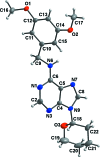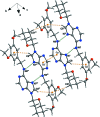6-(3,5-Dimeth-oxy-benzyl-amino)-9-(oxan-2-yl)-9H-purine
- PMID: 23634074
- PMCID: PMC3629587
- DOI: 10.1107/S1600536813006697
6-(3,5-Dimeth-oxy-benzyl-amino)-9-(oxan-2-yl)-9H-purine
Abstract
The mol-ecule of the title compound, C19H23N5O3, contains six-membered pyrimidine and five-membered imidazole rings merged into the essentially planar purine skeleton (r.m.s. deviation = 0.01 Å). In the crystal, pairs of N-H⋯N hydrogen bonds link mol-ecules into inversion dimers. The dimers are linked via C-H⋯O hydrogen bonds, forming double-stranded chains propagating along [001]. These chains are linked via C-H⋯π and parallel slipped π-π inter-actions [centroid-centroid distance = 3.467 (1) Å; slippage 0.519 Å], forming a three-dimensional network.
Figures





References
-
- Agilent (2012). CrysAlis PRO Agilent Technologies Ltd, Yarnton, Oxfordshire, England.
-
- Brandenburg, K. (2011). DIAMOND Crystal Impact GbR, Bonn, Germany.
-
- Cremer, D. & Pople, J. A. (1975). J. Am. Chem. Soc. 97, 1354–1358.
-
- Sheldrick, G. M. (2008). Acta Cryst. A64, 112–122. - PubMed
-
- Soriano-Garcia, M., Avellaneda, C. R. & Aguirre-Hernandez, G. (2003). Anal. Sci. 19, 1343–1344. - PubMed
LinkOut - more resources
Full Text Sources
Other Literature Sources
Research Materials
Miscellaneous
